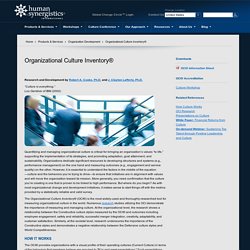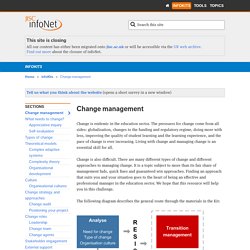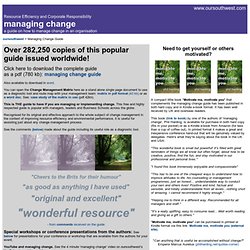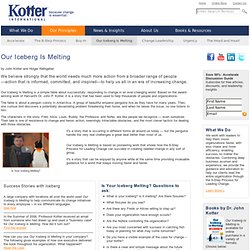

Organizational Culture Inventory - measuring organizational culture. Research and Development by Robert A.

Cooke, Ph.D. and J. Clayton Lafferty, Ph.D. CHAMPS2 Business Change Method. Embracing Change Workshops, Seminars & Presentations. Change This - We're on a mission to spread important ideas and change minds. 7 Tools to Assess and Accelerate Organizational Culture Change. What is Organizational Culture? “Organizational culture is the sum of values and rituals which serve as ‘glue’ to integrate the members of the organization.”- Richard Perrin Organizational culture can be described as the shared norms; unspoken rules, underlying assumptions; behaviours and expectations that govern the way people approach their work and interact with each other.
Such norms and expectations shape how the organizational members believe they are expected to behave in order to fit in, get things done, and navigate through organizational politics. Organizational cultures are complex as they made up of multiple layers that have developed over time by influential characters. We have all had the feeling of arriving in a new organization and questioning some of the actions, but these actions have become so ingrained as “the way things are done around here” that they have become habit and people have stopped questioning the way they do things.
Tools to assess Organizational Culture. Stakeholder Engagement: Opportunities, Types and Vehicles. Linda Ackerman Anderson Dean Anderson Creating an effective stakeholder engagement strategy is an extremely important aspect of your overall change strategy. The more engagement you have, the more commitment and positive contribution you will have, and, as engagement goes up, resistance goes down. However, stakeholder engagement is not easy. It takes time and resources to coordinate involvement, and takes people away from their normal operational jobs.
This article will help you think through the key aspects of stakeholder engagement in preparation for designing your engagement strategy. Engage in What? William Bridges and Associates Transition Training Speaking and Consulting Resources. +kenwilber.com. Change Management infoKit - Overview and Introduction. Change is endemic in the education sector.

The pressures for change come from all sides: globalisation, changes to the funding and regulatory regime, doing more with less, improving the quality of student learning and the learning experience, and the pace of change is ever increasing. Managing change. Change management process - Human Resources. Adkar Powerpoint Designing Educational. Managing Change Guide. If you would like to download a word version of the managing change guide click here: Part 1 - Managing Change (word) Part 2 - Worst Practice Guide (in Energy & Environmental Management) (word) Part 3 - Influencing Senior Management - Getting It Wrong (word) Written by Phil Harding (philharding.net) and John Pooley (The John Pooley Consultancy) this guide was first produced by the Government Office for the South West (Sustainability & Environmental Technologies Team) in partnership with Envirowise (now part of WRAP) in 2004 and re-published as a paperback in 2007 for its 4th print run.

It is also endorsed by the Carbon Trust, ESTA (the Energy Services and Technology Association), and Climate SouthWest. © Government Office for the South West, 2004 - 2007. Special workshops or conference presentations from the authors. Heading 1.
The McKinsey 7S Framework - Strategy Skills Training from MindTools. Ensuring That All Parts of Your Organization Work in Harmony Learn how to use the 7-S Framework, with James Manktelow & Amy Carlson.

How do you go about analyzing how well your organization is positioned to achieve its intended objective? This is a question that has been asked for many years, and there are many different answers. Some approaches look at internal factors, others look at external ones, some combine these perspectives, and others look for congruence between various aspects of the organization being studied. Ultimately, the issue comes down to which factors to study.
While some models of organizational effectiveness go in and out of fashion, one that has persisted is the McKinsey 7-S framework. The 7-S model can be used in a wide variety of situations where an alignment perspective is useful, for example, to help you: The McKinsey 7-S model can be applied to elements of a team or a project as well. The Seven Elements Let's look at each of the elements specifically: Force Field Analysis - Decision-Making Skills from MindTools. Analyzing the Pressures For and Against Change How to use Force Field Analysis, with James Manktelow & Amy Carlson.

Force Field Analysis is a useful decision-making technique. It helps you make a decision by analyzing the forces for and against a change, and it helps you communicate the reasoning behind your decision. You can use it for two purposes: to decide whether to go ahead with the change; and to increase your chances of success, by strengthening the forces supporting change and weakening those against it. About the Tool Force Field Analysis was created by Kurt Lewin in the 1940s. Lewin's Change Management Model - Change Management Training from MindTools.
Understanding the Three Stages of Change Find out about Lewin's Change Management Model, in this short video.

Change is a common thread that runs through all businesses regardless of size, industry and age. Our world is changing fast and, as such, organizations must change quickly too. Organizations that handle change well thrive, whilst those that do not may struggle to survive. The concept of "change management" is a familiar one in most businesses today. One of the cornerstone models for understanding organizational change was developed by Kurt Lewin back in the 1950s, and still holds true today. Understanding Lewin's Model If you have a large cube of ice, but realize that what you want is a cone of ice, what do you do? Fisher's process of personal transition curve, personal construct psychology theory.
Kotter International - The 8-Step Process for Leading Change. Kotter International - Our Iceberg Is Melting. By John Kotter and Holger Rathgeber We believe strongly that the world needs much more action from a broader range of people—action that is informed, committed, and inspired—to help us all in an era of increasing change.

Our Iceberg Is Melting is a simple fable about successfully responding to change in an ever-changing world. Based on the award-winning work of Harvard's Dr. John P. Kotter, it is a story that has been used to help thousands of people and organizations. The fable is about a penguin colony in Antarctica. The characters in the story, Fred, Alice, Louis, Buddy, the Professor, and NoNo, are like people we recognize — even ourselves.
Our Iceberg Is Melting Book Summary On the surface, Our Iceberg Is Melting is a simple story of a colony of penguins facing a dilemma. To help you understand the story a little bit better, we’d like to introduce you to some of the characters in the book below. The Inconvenient Truth about Change Management_May 08.indd. The Change Leader's Roadmap - Change Management Methodology. ADKAR Change Management Model Overview - Change Management Learning Center. Overview.

Change Management Learning Center - Change management books. Change Management Training, Leadership, Strategy, Method & Toolkits, Change Coaching & Consulting.